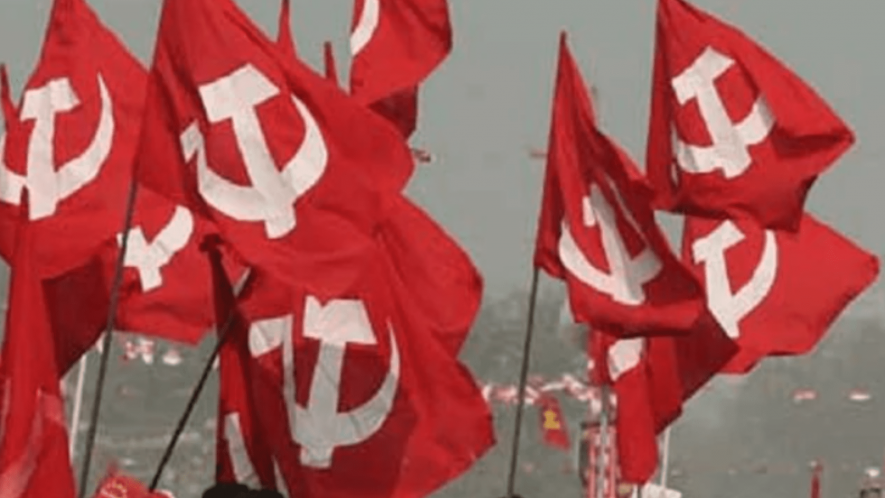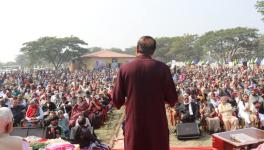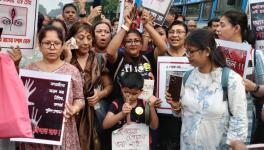The Phoenix Moment: Challenges Before the Left in Bengal

File Image
Assembly election results in five states, barring Assam, carry the same message —reject the Bharatiya Janata Party.
The results of Kerala and West Bengal are astonishing. The Left has broken the past records -- for both good and worst. In the former, it has returned to power riding the wave of planned and inclusive development, extraordinary handling of the COVID-19 crisis, and deflating the wheels of the Hindutva chariot that was on the move since the Sabarimala judgment. On the contrary, in West Bengal, the Left has failed to secure even a single seat. For the first time in the history of independent India, the West Bengal Assembly would be bereft of communist legislators.
From a vote share of around 20% in the 2016 Assembly elections, 6.34% in the 2019 Lok Sabha elections, and 4.6% in the 2021 elections, the Communist Party of India (Marxist) has registered a perennial fall. The fall of CPI(M) was concomitant with the rise of BJP in Bengal. From 4.6% in 2011, 10.75% in 2016, 40.64% in 2019, and around 38% in 2021, BJP’s rise has been geometric, to say the least. The 2.64% fall in the vote share along with an 8% increase in the vote share of Trinamool Congress or TMC, proved to be a blow for BJP in Bengal.
What explains the rise and fall of BJP's vote share in the state? Three points immediately come to mind. First, the communal polarisation wrought by BJP, which brought 18 seats into its kitty in 2019 Lok Sabha polls, was only ‘partially’ successful. Partially, because it remained short of capturing power. The Sangh Parivar would certainly be grinning secretly at putting a full-stop to TMC leader Mamata Banerjee’s favourite election time dress, the hijab, and making her recite the chandipath (a religious hymn sung in honour of Hindu goddess Durga).
Like any other politician battling the BJP, Mamata Banerjee was forced to peddle soft Hindutva and openly declare her Brahmin gotra (mythic-ancestral descent), very much like Rahul Gandhi did during the Madhya Pradesh elections. However, unlike him, she fell short of flaunting the janeu (sacred thread), primarily because it remains the preserve of upper-caste male Hindus, and women are not allowed to wear it.
Also read: Bengal Elections: BJP’s Half-Empty Glass a Sign of the Times
Second, the people of Bengal rejected the open horse-trading initiated by BJP. Rallies by Home Minister Amit Shah became makeshift bazaars wherein democracy was put up for sale. Ruling as well as some Opposition party leaders were auctioned like mares and mules. So, for anyone seeking poriborton (change), it was clear that s/he would be riding the same animal of which s/he had grown tired. The difference would lie only in the deeper dash of vermilion on the forehead.
The hubris of the ‘Mo-Shah’ duumvirate, gross mismanagement of the pandemic, holding of elections in eight phases in criminal disregard for public health, open misogyny of the state BJP leaders, preponderant threat of the CAA-NRC (Citizenship Amendment Act- National Register of Citizens) allowed Mamata Banerjee to become the sole beneficiary of cross-class dissatisfaction against BJP. And all such dells and streams of dissatisfaction flowed into the TMC’s vote reservoir.
It must be kept in mind that Mamata Banerjee supported the CAA, 2003, enacted by the then BJP-led National Democratic Alliance government; she marshalled her party to vote against the no-confidence Bill brought out by the Opposition against the Atal Bihari Vajpayee’s government in the aftermath of the Gujarat pogrom and most recently, her party’s election manifesto, 66 pages in length, did not have a single line against the implementation of CAA-NRC in Bengal.
Third, and most crucially, the Left’s alliance failed to cut ice with common voters. Neither the minority nor anti-incumbency votes went in its favour. On the contrary, it can be conjectured that around 1.74% of its votes went to the TMC in a desperate bid to stop the BJP from holding the reins of power.
Why did the ‘pooling of votes’ strategy fail? The answer lies in the nature of the political situation facing the Left. The BJP is not a fascist party in the classical sense of the term against which a united front is always necessary. Indian politics, history has taught us, oscillates between different forms of authoritarianism, and the BJP’s is a ruthless communal version of it. Congress’s version during Indira Gandhi’s tenure and later its corrupt manifestation under her son, Rajiv, necessitated a broad-based unity. But all such broad-based unities were short-lived and would continue to be so in the future.
Also read: With ‘Double Century’, Mamata Registers Historic Win in Highly Polarised Bengal Elections
For instance, when V.P Singh’s government was supported by both the Left and BJP from the outside, a beleaguered socialist leader Chandrashekhar smelt an opportunity to pull the rug from under Singh’s government. He allied with the opportunist Congress, which later dumped him on the flimsy charge of using two constables to spy on Rajiv Gandhi.
The vagary of Indian democracy always impedes a truly progressive coalition to stamp out authoritarianism. All such coalitions are always predicated upon selfish interests of the member parties, as the latter are always interested in snatching their pound of flesh as cabinet ministries and other such sweet fruits which come along with high power. The only exception to this was the Congress-led United Progressive Alliance-I wherein the Left had 60 seats, chose not to take cabinet births, and acted as the ‘watchdog’ of the ruling dispensation.
This compromise, too, was to stop BJP from coming to power. But with the benefit of hindsight and keeping in mind the existing carnage wrought by BJP, one is forced to ponder: was the coalition game worth the candle? In the short run, yes, and in the long run, no.
In the short run, the Left ensured the passage of a slew of progressive legislations but in the long run, the periodic crises of bourgeois democracy again necessitated the rise of a new communal authoritarianism under BJP. And this time, authoritarianism was dialectical in nature—ultra-modern and conservative at the same time. On one hand, its IT cell was the most tech-savvy and consisted of an unrelenting army of virtual hate mongers; on the other hand, it made a good majority of Indians believe that the cow is the “ultimate” source of deliverance. Its urine improved health, its milk had gold, and its dung could ward off diseases!
Holding the tail of the cow, BJP swept Indian elections amid the killing of Muslims, maiming of dalits, and fooling the middle-classes on the promises of the country becoming Vishwa-guru (leader of the world). It entered Bengal at a time when the Left was ousted and its one-time trusted ally, Mamata Banerjee, was ensconced in power. TMC’s authoritarianism and violence led the Left into a seat-sharing with the Congress during the 2019 Lok Sabha polls.
Also read: Bengal Elections: How TMC Violence Against Left Opened Doors for BJP
Class politics was kept on the back-burner and the understanding with the Congress confused the voters. Congress emerged with more seats despite a much lower vote share. The enfeebling of the Left-secular pole allowed BJP to enter Bengal and emerge as the sole opposition against TMC. BJP’s rise further pushed the Left toward a formal alliance with Congress. BJP’s authoritarianism at the Centre led people to choose, perhaps its lesser version, the TMC, over the alliance.
The message is clear. Despite the Left leading relief work operations during the Amphan cyclone wherein TMC leaders engaged in wanton corruption by diverting relief funds into their own coffers; playing a central role in organising farm protests via its peasant front, the All-India Kisan Sabha; and running ‘shramik canteens’ for the poor during the COVID-19 crisis in West Bengal, it did not succeed in becoming the alternative to BJP and TMC. The contest remained an intensely bipolar one wherein the majority of voters were committed to stop the BJP from coming to power. Anti-incumbency against TMC’s misrule and wanton political violence remained largely secondary.
The Left needs to marshal all the progressive forces under its banner and focus on alliance politics in tandem with all the working class forces in Bengal. The vectors of class struggle need to be strengthened in the fight against the BJP-TMC. Ultimately, no authoritarianism can be voted to power in an electoral democracy without the (mis)guided support of the working poor. The working poor, especially in a country like India, is lacerated by multiple daggers. The prevalence of an informal economy robs it of a decent wage, casteism impedes its social mobility, and a lack of free health care and education exacerbates its overall drudgery.
In such a situation, non-class-oriented politics weans the group further away from the Left. Singular onus on secularism does not attract them in a way bread and butter issues would do. Secularism is a byproduct of working class struggle. And if the Left pole is strong, any attempt toward communalism would be automatically nipped in the bud. The absence of Hindutva politics during the Left’s 34-year rule and the recent defeat of BJP in Kerala from all the five Assembly segments in the Sabarimala district clearly attest to this.
Class struggle in India is sharpening because of the pandemic, the agrarian impasse, and the accumulation of wealth in the hands of just 1%. West Bengal is no different. Massive growth in the service sector economy at the cost of manufacturing has led to more precarious employment for the states’ workforce, mainly the youth. Bengal’s share of non-farm employment is at 61%, higher than the national average.
From 2005-2012, job creation in West Bengal remained the highest marking a 1.8% annual growth. But much of it remained within the informal and casual sector in construction and small manufacturing units. The trend has continued into the TMC’s rule. The state has over 1.5 crore workers in this unorganised sector and they are almost completely bereft of unions. As a result, they suffer heavily in terms of wage bargaining and end up greasing the fortunes of city-based contractors (a local party big-wig). The Left must focus on them and organise them into unions and workers’ cooperatives.
Also read: 11 Dead, Several Rendered Homeless in Bengal Post-Poll Violence
It is time for the Left to unite the people on larger issues such as universal health care, free education, and a minimum living wage of at least Rs 21,000. All these struggles must be fought on the streets. The working poor would certainly rally with the Left, as it is only they who can resurrect the red phoenix from its ashes.
The protesting farmers at the borders of the national capital have understood this much better than the overjoyed liberals. Gurwinder Khangura, a farmer from Hoshiarpur has clearly said that ‘the farmers are celebrating BJP’s defeat and not TMC’s victory’. The farmers during their ‘no-vote to BJP’ campaign in Bengal never campaigned for the TMC as they were aware that Mamata Banerjee has diluted the farm procurement system in Bengal, albeit surreptitiously, in 2014-17. Their strict insistence on not celebrating TMC’s victory has been vindicated in view of the violence that has been unleashed by the TMC on the Opposition parties.
In the immediate aftermath of electoral victory, several Left activists have been targeted and are being subjected to brutal violence. CPI (M) activist Kakali Khetrapal was killed while resisting TMC’s attacks in Burdwan’s Jamalpur. Over 10 houses in North 24 Parganas have been vandalised, many party offices have been torched and young comrades of the Red Volunteers group doing COVID-19 oriented relief work have been beaten up TMC-backed goons.
(The author is a research scholar with the Department of World History, University of Cambridge. The views are personal.)
Get the latest reports & analysis with people's perspective on Protests, movements & deep analytical videos, discussions of the current affairs in your Telegram app. Subscribe to NewsClick's Telegram channel & get Real-Time updates on stories, as they get published on our website.
























